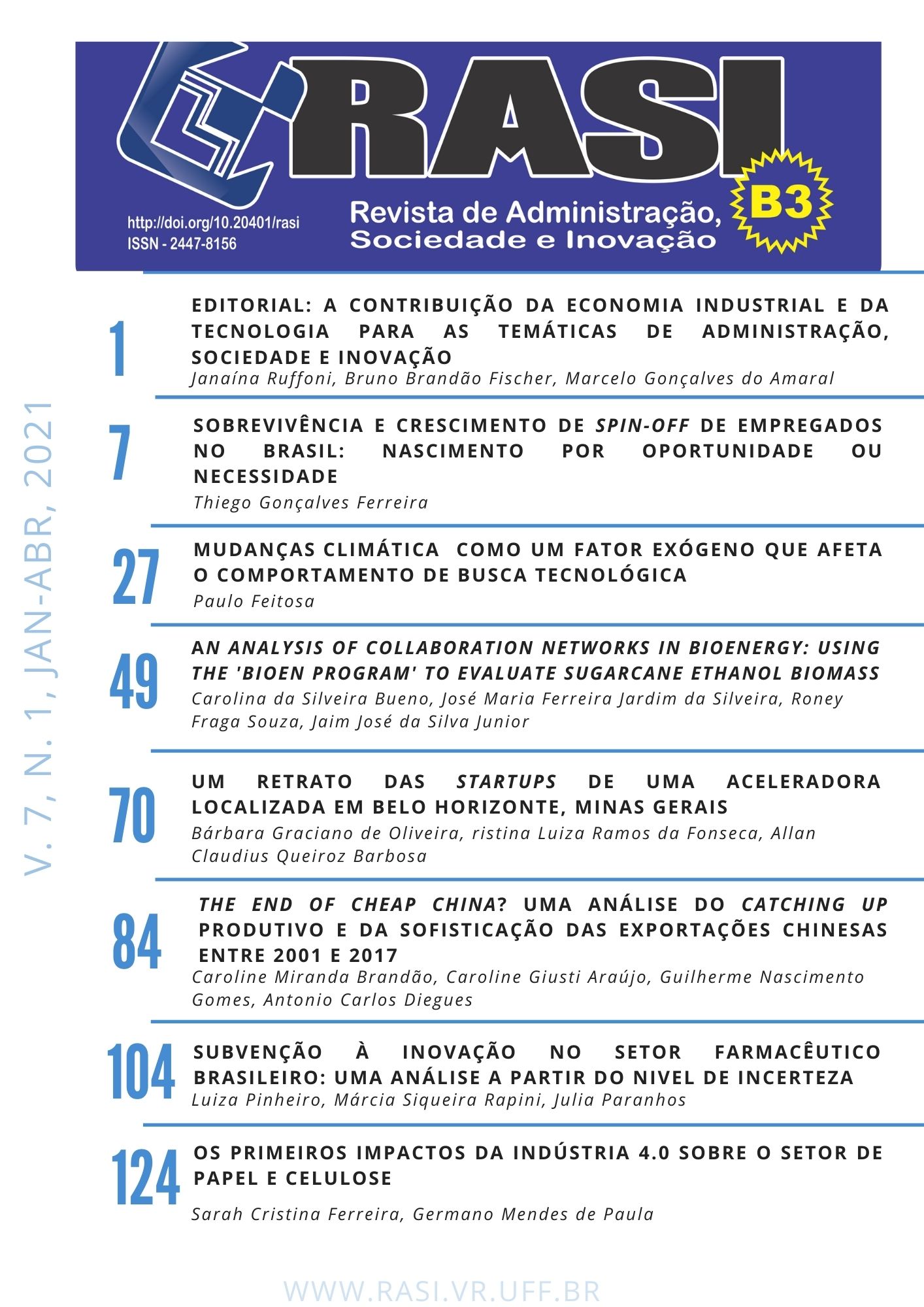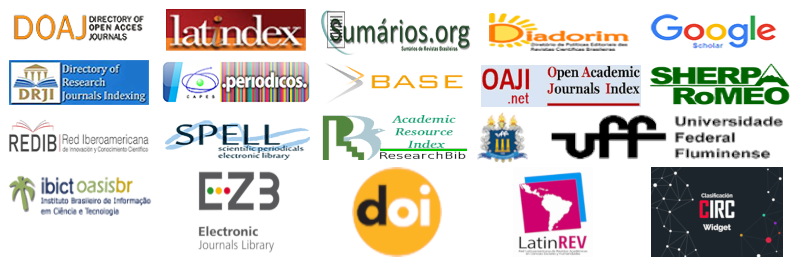The profile of the startups of an accelerator located in Belo Horizonte, Minas Gerais
DOI:
https://doi.org/10.20401/rasi.7.1.515Keywords:
Entrepreneurship, Innovation, StartupAbstract
The renewal and development of an economy depend on innovation, which is closely related to new ventures and startups. This article aims to characterize existing startups in the innovation ecosystem of Belo Horizonte (Minas Gerais - Brazil), considering the startups present in an Acceleration Program. For achieving this purpose, a qualitative research with a descriptive approach and a case study focusing on the Techmall S.A. Acceleration Program was adopted. The results revealed the profile of the entrepreneur, predominantly young, without previous entrepreneurial experience and with degree in Exact Sciences. As for Startups, most are in operation in several segments; received some award and are not aresult of academic or business spin-offs. The predominant form of hiring employees is temporary internship and scholarship regime. The results presented the main challenges faced by the startups are escalating sales and attracting customers (internal challenges), and taking initial capital, financing and foreign investments (external challenges). To face such challenges, the accelerator should assist in mapping customers and determining sales strategies, considering that this is one of the difficulties found. Finally, the study concluded that it is necessary that the Minas Gerais Innovation Ecosystem be aware of the challenges encountered, in order to formulate policies to minimize them.
Downloads
References
Abernathy, W. J., & Utterback, J.M. (1978). Patterns of industrial innovation. Technology Review, 80(7). p. 40-47. Disponível em: <http://www.academia.edu/download/50444122/Abernathy1978.pdf>. Acesso em: 19/07/2020.
Acs, z. J.& amorós, J. E. (2008) Introduction: The startup process. Introduction: Estudios de Economía. 35(2), dezembro, p. 121-132. Disponível em: <http://www.econ.uchile.cl/uploads/publicacion/867c6c35-923c-4251-8ce3-9585eee8e443.pdf>. Acesso em: 19/07/2020.
Antunes, L. G. R., Araújo, G. S., & Almeida, K. C. (2020). Estabelecendo o Modelo de Negócio de Incubadoras. Revista de Administração, Sociedade e Inovação, 6(1), 5-23. DOI: https://doi.org/10.20401/rasi.6.1.318.
Armanios, D. E. et al. (2017). How entrepreneurs leverage institutional intermediaries in emerging economies to acquire public resources. Strategic Management Journal, 38(7), p. 1373-1390. DOI: https://doi.org/10.1002/smj.2575.
Associação brasileira de startups - ABSTARTUPS. Disponível em: <https://abstartups.com.br>. Acesso em: 16/11/2017.
Cockayne, D. (2019). What is a startup firm? A methodological and epistemological investigation into research objects in economic geography. Geoforum, 2019. DOI: https://doi.org/10.1016/j.geoforum.2019.10.009.
Cohen, S.; Fehder, D. C.; Hochberg, Y. V.& Murray, F. (2019). The design of startup accelerators. Research Policy, 48(7), p. 1781-1797. DOI: https://doi.org/10.1016/j.respol.2019.04.003.
Cohen, S. & Hochberg, Y. V. (2014). Accelerating startups: The seed accelerator phenomenon. cohen, susan and Hochberg, Yael V., Accelerating Startups: The Seed Accelerator Phenomenon (March 30, 2014). SSRN: https://ssrn.com/abstract=2418000. DOI: http://dx.doi.org/10.2139/ssrn.2418000
Cohen, S. (2013). What do accelerators do? Insights from incubators and angels. Innovations: Technology, Governance, Globalization, 8 (3-4), p. 19-25. Disponível em: <https://www.mitpressjournals.org/doi/pdf/10.1162/INOV_a_00184>. Acesso em: 19/07/2020.
Cusumano, M. A. (2013). Evaluating a startup venture. Communications of the ACM, 56(10), 26-29.
Da Costa Nogami, V. K. (2019). Destruição criativa, inovação disruptiva e economía compartilhada: uma análise evolucionista e comparativa. Revista Suma de Negocios, 10(21) p. 9-16. DOI:10.14349/sumneg/2019.V10.N21.A2
De Sousa, J. C., Júnior, L. A. F., & Nobrega, K. C. (2020). Entrepreneurial Strategies and Innovative Strategies: Bibliometric review, concepts, models and future investigations. Revista de Administração, Sociedade e Inovação, 6(2) maio-agosto 2020. DOI: https://doi.org/10.20401/rasi.6.2.425
Del Sarto, N., Isabelle, D. A., & Di Minin, A. (2019). The role of accelerators in firm survival: An fsQCA analysis of Italian startups. Technovation, 90, p 102102. DOI: doi:10.1016/j.technovation.2019.102102
Dempwolf, C., S.; Au, R, J., & D’ippolito, M.. (2014). Innovation Accelerators: Defining Characteristics Among Startup Assistance Organizations. SBA Office of Advocacy, Optimal Solutions Group, LLC, College Park.
Dolabela, F. (2008). O segredo de Luísa. Uma ideia, uma paixão e um plano de negócios: como nasce o empreendedor e se cria uma empresa. Rio de Janeiro: Sextante.
Dornelas, J., C., A. (2016). Empreendedorismo: Transformando Ideias em Negócios. 6ª edição. Atlas.
Etzkowitz, H., & Zhou, C. (2017). Hélice Tríplice: inovação e empreendedorismo universidade-indústria-governo. Estudos avançados, 31(90), 23-48. DOI: https://doi.org/10.1590/s0103-40142017.3190003
Hunt, R. A. (2012). Entrepreneurial" Tweaking": An Empirical Study of Technology Diffusion through Secondary Inventions and Design Modifications by Start-Ups. Frontiers of Entrepreneurship Research, 32(15), 1. DOI:10.1108/14601061311324511
Kohler, T. (2016). Corporate accelerators: Building bridges between corporations and startups. Kelley School of Business, Indiana University, Elsevier.
Kovács, I. (2003) Inovação organizacional. In: Rodrigues, M.J.; Neves, A.; Godinho, M.M. (Org.) Para uma política de inovação em Portugal. Lisboa: Publicações Dom Quixote.
Kulchina, E. (2017). Do foreign entrepreneurs benefit their firms as managers? Strategic Management Journal, 38(8) p. 1588-1607. DOI: https://doi.org/10.1002/smj.2618
Leung, A., Zhang, J., Wong, P. E Foo, M. D. (2006). The Use of Networks in Human Resource Acquisition for Entrepreneurial Firms: Multiple "Fit" Considerations. Elsevier: Journal of Business Venturing, 21(5) p. 664-686. DOI: https://doi.org/10.1016/j.jbusvent.2005.04.010
Lins Filho, M. L., de Andrade, A. P. V., & da Silva, G. G. (2020). Capacidade de inovar em STARTUPs: Uma abordagem sob a ótica da orientação para aprendizagem. Navus-Revista de Gestão e Tecnologia, 10, 01-21. DOI: https://doi.org/10.22279/navus.2020.v10.p01-21.1095
Machado, F. G. (2015). Investidor-anjo: Uma análise dos critérios de decisão de investimento em Startups. Dissertação, Faculdade de Economia, Administração e Contabilidade. Universidade de São Paulo.
Matos, F. (2017). Qual a região campeã em densidade de startups no Brasil? O Estado de S. Paulo, São Paulo, 30 out. 2017. Disponível em: < https://link.estadao.com.br/blogs/felipe-matos/qual-a-regiao-campea-em-densidade-de-startups-no-brasil-voce-vai-se-surpreender/>. Acesso em: 11 out. 2019.
Mian, S., Lamine, W., Fayolle, A. (2016). Technology Business Incubation: An overview of the state of knowledge. Technovation. 50–51, p. 1-12. DOI: https://doi.org/10.1016/j.technovation.2016.02.005
Nogueira, V. & Arruda, C. (2015). Causa da Mortalidade de Startups Brasileiras: O que fazer para aumentar as chances de sobrevivência no mercado? Fundação Dom Cabral, DOM. Nova Lima, v.9, n. 25, p. 26-33, nov./fev. 2014/2015. Disponível em: <https://www.fdc.org.br/conhecimento/publicacoes/artigo-29767>. Acesso em: 19/07/2020.
O’Connell, B. (2011). Start X: Training ground for Stanford’s best and brightest. Kauffman Foundation.
Perin, B. (2015). A Revolução das Startups: O Novo Mundo do Empreendedorismo de Alto Impacto. Alta Books; 1ª Edição. [Ebook]
Radojevich-Kelley, N. & Hoffman, D. L. (2012). Analysis of accelerator companies: An exploratory case study of their programs, processes, and early results. Small Business Institute Journal, 8(2) p. 54-70. Disponível em: <https://www.sbij.org/index.php/SBIJ/article/view/136>. Acesso em: 19/07/2020.
Ramírez, C. P., Moreno, A., Améstica, L., & da Silva, S. S. (2019). Incubadoras en red: capital relacional de incubadoras de negocios y la relación con su éxito. Revista de Administração, Sociedade e Inovação, 5(2), 162-179. DOI: https://doi.org/10.20401/rasi.5.2.316
Reis, D. A., & de Aragão Gomes, I. M. (2017, October). Capital Humano, Intensidade da Inovação e crescimento econômico no Brasil. In: 8th International Symposium on Technological Innovation. Disponível em: <http://www.api.org.br/conferences/index.php/ISTI2017/ISTI2017/paper/viewFile/231/141<. Acesso em: 27/07/2020
Ries, E. (2011). The Lean Startup: How Today's Entrepreneurs Use Continuous Innovation to Create Radically Successful Businesses. Hardcover.
Salamzadeh, A. & Kesim, H., K..(2015). Startup Companies: Life Cycle and Challenges. Proceedings of the 4th International Conference on Employment, Education and Entrepreneurship (EEE), Belgrade, Serbia, 2015.
Santos, P. C. F. dos. (2008). Uma escala para identificar potencial empreendedor / Paulo da Cruz Freire dos Santos; Orientador Álvaro Guillermo Rojas Lezana. – Tese (Doutorado) – Universidade Federal de Santa Catarina, Programa de Pós-Graduação em Engenharia de Produção.
SEBRAE. O que é uma startup?. Disponível em: <https://www.sebrae.com.br/sites/PortalSebrae/sebraeaz/o-que-e-umastartup,616913074c0a3410VgnVCM1000003b74010aRCRD>. Acesso em: 15/11/18.
Startup Brasil. Programa Startup Brasil. Disponível em: < https://www.startupbrasil.org.br/sobre_programa/> . Acesso em: 14/01/18.
Stayton, J., Mangematin, V. (2019) Seed accelerators and the speed of new venture creation. J Technol Transf 44, 1163–1187. DOI: https://doi.org/10.1007/s10961-017-9646-0
Teixeira, A. A. C. (2007). Excesso de Incentivos à Inovação na Presença de Consumidores Sofisticados. Um Modelo de Progresso Tecnológico Endógeno com Capital Humano. Estudos Econômicos, 37 (3). DOI: https://doi.org/10.1590/S0101-41612007000300006
Vohora, A.; Lockett, A.& Wright, M. (2004). The formation oh high-tech university spinouts: the role of joint ventures and venture capital investors. The Journal of Technology Transfer, 29(3-4), p.287-310. Disponível em: <https://link.springer.com/article/10.1023/B:JOTT.0000034124.70363.83>. Acesso em 19/07/2020.
Yin, R. K. (1994). Estudo de Caso-: Planejamento e métodos. Bookman editora.
Weiblen, T.& Chesbrough, H., W. (2015). Engaging with Startups to Enhance Corporate Innovation. California Management Review 57(2): 66-90, University of California Press. DOI: https://doi.org/10.1525/cmr.2015.57.2.66
Downloads
Published
Issue
Section
License
Copyright (c) 2020 Review of Administration, Society and Innovation

This work is licensed under a Creative Commons Attribution 4.0 International License.
RASI, in accordance with Law No. 9,610 of February 19, 1998, which amends, updates and consolidates Brazilian copyright law and makes other provisions, adopts the following conditions of the Copyright Assignment:
1. RASI maintains, with the transfer of copyrights, the possession of rights over the content published;
2. The author retains his moral rights of the content, including the right to be identified as the author whenever the content is published;
3. Despite the attribution of copyright, the author retains the right to reuse the material in future collections of his own work without encumbrance. The acknowledgments of the previous publication in the RASI are the only requirements in such cases;
4. The author may make photocopies of the content, or distribute it by electronic mail or fax, provided that they are intended for their own classes and for the purpose of meeting research objectives, provided that: (a) such copies are not resold and (b) reference to the original source of the publication and the name of the RASI are clearly indicated on all copies made of the document.











